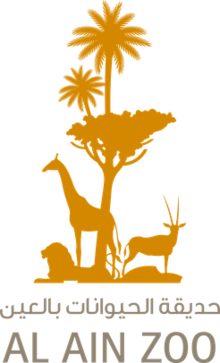Al Ain Zoo
 | |
|
Al Ain zoo entrance | |
| Date opened | April 7, 1968 |
|---|---|
| Location | Al Ain, United Arab Emirates |
| Coordinates | 24°10′34″N 55°44′19″E / 24.176081°N 55.738492°ECoordinates: 24°10′34″N 55°44′19″E / 24.176081°N 55.738492°E |
| Land area | 400 ha (990 acres) |
| Memberships | WAZA[1] |
| Website |
www |
Al Ain Zoo (Arabic: مـنـتـزه الـعـيـن لـلـحـيـاة الـبـريـة) is a 400-hectare (990-acre) zoo located in the foothills of Jebel Hafeet in Al Ain, Emirate of Abu Dhabi, the United Arab Emirates. It is primarily composed of Ungulates and herbivores such as Arabian antelopes and oryx, eland, gazelle, lechwe and can be found in the tree shaded paddocks which offer breeding conditions that were deemed 'excellent'.[2]
The Al Ain Zoo hosts the rare white lion.
History and fauna
The zoo features a big cat house. Lions, cougars, jaguars, black and spotted leopards are found here. In addition to this, it also has a reptile house, monkey compounds, aquarium, and aviary. From February 2010 until July 2010, the Al Ain Zoo hosted the "Dinosaur Trail", a small section which includes around 15 to 20 mechanical dinosaurs with sensors such as Tyrannosaurus rex, as well as information about the dinosaur such as when they lived, which parts of the (current) world they would have been found, and their height and diet, for example.
There is a bird show featuring predatory birds and night birds that lasts 30 minutes starting at 7 pm. The dinosaur trail is open until 8 pm. Wheelchairs are available on request. To walk around the zoo and see all the animals, besides the Dinosaur Trail, would take approximately 2 hours. The zoo also has a "train" with open carriages. It does not enter the "yellow" section which hosts the African lion, Bengal tiger, chimpanzee, puma, saltwater crocodile, panther, Nile crocodile, and leopard. The zoo is home to over 4,000 animals, with at least 30% of its 180 species considered endangered. Conservation efforts have been strengthened by partnerships with San Diego Zoo. This 900 ha (9.0 km2) park near the base of Jebel Hafeet is where visitors can see a large animal collection in enclosures that closely resemble their natural habitats. There are plenty of green public spaces for picnics and also playgrounds, a cafeteria and a train tour of the wildlife area. Giraffe feeding, camel riding and 'Elezba' petting zoo are the latest interactive activities. Visitors can enjoy feeding the giraffe treats such as carrots or lettuce five times daily in a special area. Designed in the style of a local farm, the 'Elezba' petting zoo lets families feed and play with sheep, goats, camels, llamas, chicken and ducks, enjoy camel riding or picnic in a designated area. A fun-filled, outdoor learning scheme designed to inspire children with a love for biodiversity, this garden beauty of plants. The garden features a rolling hill, mixed-use play areas, picnic spots, a flower garden and native plant garden with species indigenous to the UAE, a recycling garden and a vegetable, fruit and herb garden. With spectacular African Baobab trees framing the area, the towering trunks offer a genuine horticulture lesson in how specific plants can adapt to dry soil conditions.
The zoo is currently preparing to expand with work on its perimeters going on at the moment in order to build new sites such as the conservation and breeding centre, African Safari, World Desert Zoo, Sheikh Zayed Desert Learning Centre.
Gallery
See also
References
- ↑ "Currently Accredited Zoos and Aquariums". aza.org. AZA. Retrieved 1 April 2012.
- ↑ Lee, J. "Excellent breeding conditions in Al Ain Zoo, United Arab Emirates". www.planetware.com. Archived from the original on 9 February 2010. Retrieved 2010-02-06.
- ↑ Edmonds, J.-A.; Budd, K. J.; Al Midfa, A. & Gross, C. (2006). "Status of the Arabian Leopard in United Arab Emirates" (PDF). Cat News (Special Issue 1): 33–39.
- ↑ Spalton, J. A. & Al-Hikmani, H. M. (2006). "The Leopard in the Arabian Peninsula – Distribution and Subspecies Status" (PDF). Cat News (Special Issue 1): 4–8.
External links

- Official website
_Tswalu.jpg)
